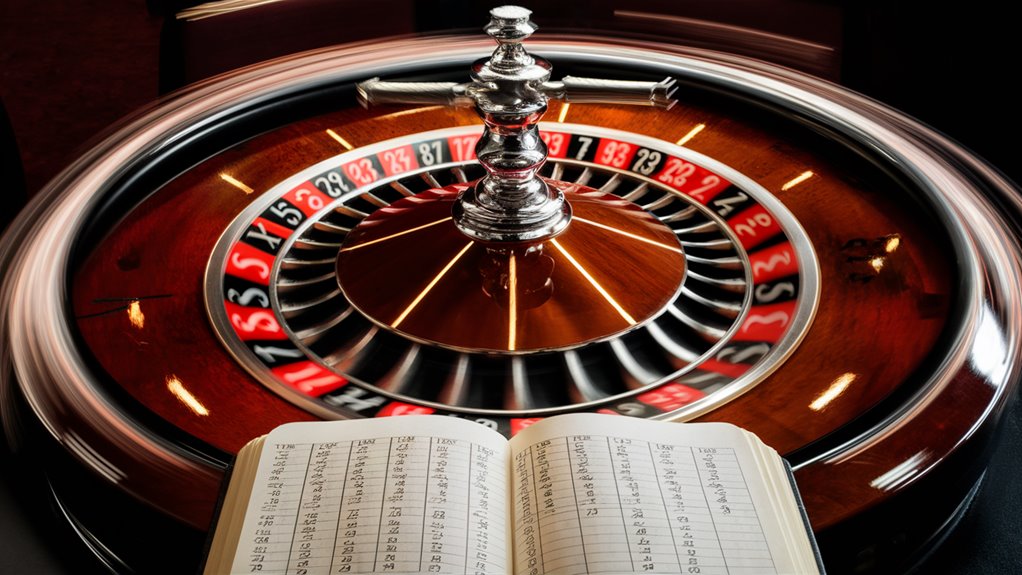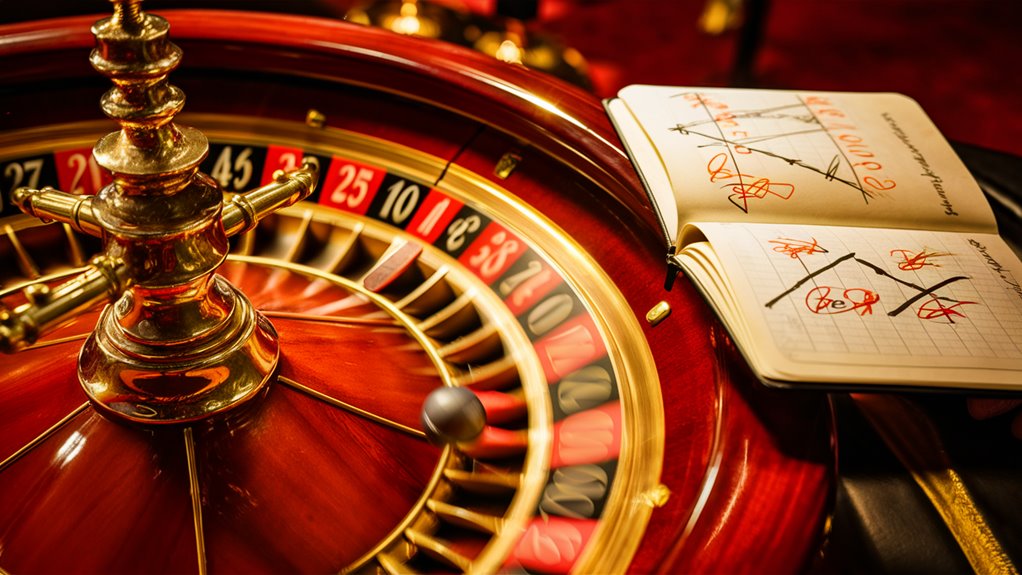Table of Contents
ToggleThe Simple Math of Roulette Myths

How the House Always Wins
In roulette, the math shows a firm house edge – 2.7% for European roulette and 5.26% for American roulette. No matter the player’s plan or bet style, these numbers do not change.
Each Spin is a New Chance
Every turn of the roulette wheel is its own thing, and each bet has a 1/37 chance in European roulette. This proves that past spins cannot tell us what will happen next.
Why Betting Systems Fail
The Martingale system and others like it hit two big walls: unchanging math odds and table limits. No bet trick can beat the basic edge that math gives the house.
The Problem with Hot and Cold Numbers
Tracking “hot” or “cold” numbers offers no real math edge. This belief is a gambler’s fallacy – a wrong idea that goes against how math works.
Math vs. Guessing Patterns
People like to find patterns, but roulette works on raw probability theory. The math behind the game shows why thinking you see patterns will not work.
The Odds at Play
Knowing these math truths shows why winning over the roulette house edge is just not possible. The game’s odds make sure casinos make money over time, keeping math odds fixed at each spin.
What the House Edge Really Means
The House Edge in Casino Games 먹튀검증사이트
House Edge Explained
The house edge is what gives the casino its math advantage in games.
In European roulette, one zero means a 2.7% house edge, while in American roulette, an extra zero ups this to 5.26%.
These rates come from deep math work that runs the game.
What This Costs You
If you play with $100 in European roulette, expect to lose $2.70 over time.
This math downside stays the same, no matter how you bet.
The math builds on the 37 possible spots in European roulette, where a straight win pays 35 to 1, making the constant 2.7% edge.
House Edge in Different Games
No betting systems can beat the built-in math downside in roulette.
An extra zero in American roulette lifts the house edge big time, making European roulette a better math bet for players.
All bets – like straight, split, corner, and column bets – keep the house edge rate the same in their game type.
The Pitfall of the Martingale System
The Martingale System: A Math Breakdown
How the Martingale Strategy Works
The Martingale system is a well-known betting trick, promising sure wins by doubling bets on each loss.
This deep look shows why this often used method ends in loss, even though it seems simple.
The Raw Math of Martingale
The progressive betting method has deep flaws when you look at the math.
Starting with a $10 bet, lose once, and you bet $20; lose twice, it’s $40; and so on:
- Loss 1: You need $20
- Loss 2: You need $40
- Loss 3: You need $80
- Loss 4: You need $160
- Loss 5: You need $320
- Loss 6: You need $640
Why Martingale Doesn’t Work
Three big limits block Martingale success:
- Table Limits: Casinos set max bets that stop you from doubling forever
- Money Limits: Even a $10,000 budget only takes 10 straight losses
- Steady House Edge: No matter how you bet, the house edge doesn’t swing
Looking at the Long Game
Math odds show that while you might win now and then, the system’s setup ensures you lose eventually.
A string of losses, bound to happen over time, wipes out all past wins and often is more than both table limits and what you can spend.
The expected value stays negative with each bet, making long-term wins not possible, no matter your bet plan or money tricks.
About Hot and Cold Numbers
Hot and Cold Numbers in Roulette: A Math Look

The Reality of Number Tracking
Roulette number tracking pulls in players who watch for “hot” and “cold” numbers, thinking past spins hint at what comes next.
This deep dive shows why such pattern bets clash with math odds.
Roulette Spins Stand Alone
Every roulette spin is its own case, not tied to what happened before or what will happen next.
On a European roulette wheel, the chance stays the same at 1/37 (2.7%) for any number each time. A number not seen lately (cold) has the same odds of coming up as one that has shown up a lot (hot).
Why the Gambler’s Fallacy Is Wrong
The gambler’s fallacy idea shows this idea with a coin toss.
After ten heads in a row, tails still have a 50% shot next time. This math truth holds in roulette too – past spins do not change future odds.
How Randomness Really Works
The physical bits of roulette wheels, like:
- Air push-back
- First speed
- Wheel tune-up
- Ball acts
These parts work together for truly random results each spin. The wheel’s build makes sure one spin doesn’t affect the next, making hot and cold number tracking not useful for guessing what comes next.
Understanding the Odds
Getting the odds right is key to smart betting.
Seeing patterns in roulette is more about mind tricks than real chances. The steady odds of each outcome show why past result lists don’t help guess future spins.
Past Doesn’t Change the Future
Roulette Odds: Past and Future Spins
The Math of Roulette Spins
Each roulette spin stands on its own, linked by nothing to past spins.
The math odds stay solid at 1/37 for European roulette and 1/38 for American roulette, no matter what happened before.
These core odds don’t shift, clearing up wrong ideas about pattern betting in roulette.
Why the Gambler’s Fallacy Doesn’t Hold
The Gambler’s Fallacy is a common mistake in thought about odds in casino games.
When players see many same results in a row, they wrongly think the opposite result is more likely.
For instance, after 10 black numbers in line, the chance of red stays just 18/37 on a European wheel, the same as any spin.
The Science of Each Spin
Things like push, rub, and pull from gravity work alone each time.
The roulette wheel can’t remember or use past spins to sway what happens next.
This mechanical and math independence stops any try at pattern betting as it’s just not based in science.
Key Points:
- Each spin keeps the same odds
- Past outcomes don’t touch what comes next
- Pattern bets don’t stand up to math
- Physical bits reset fully between spins
The true chance in roulette stops any hope of betting based on what has happened before, making each spin truly its own case.
Betting Systems vs. Real Odds
Betting Systems and Roulette Odds
The Math Behind Betting Plans
Casino betting systems pull in players wanting to beat the house edge with smart bet patterns.
Yet, math tests always show these systems can’t get one over on the firm casino edge.
Breaking Down the Martingale System
The Martingale betting plan is one of the most known of these systems.
This way makes players double their bets after each loss, hoping to win back past losses with just one win. A close math look shows why this fails:
- Start with a $1 bet
- 8 straight losses (1/256 shot)
- Next bet jumps to $256
- Table caps usually stop you there
- House edge stays 5.26% on American wheels
More Complex Betting and Odds
D’Alembert and Fibonacci Plans
Other bet ways, like D’Alembert and the Fibonacci line, face the same math blocks. Key odds bits include:
- Fixed spin odds
- Each event stands alone in odds
- House edge doesn’t change
- No long-term wins are likely
The Unchangeable Math of Casino Games
The set odds rules in roulette show why betting systems fail:
- Each spin keeps the same odds
- No pattern betting sways results
- Bet size can’t twist odds
- House math edge is always there
Deep Look at Betting Results
Deep odds math confirms that no mix of bets beats the built-in house edge.
The sure math of casino gain comes from:
- Locked-in odds bits
- Each spin stands alone
- House edge works every time
- Always a math downside over time
Seeing Patterns in Roulette
Patterns in Roulette: A Math View
Getting Roulette Probabilities and Patterns
Pattern watching is a common way players set up their roulette plans.
They may spend much time marking numbers, noting order, and looking for patterns in results.
Yet, the core math rule is always there: each spin is a new event, set by exact odds work.
The Gambler’s Fallacy Made Clear
A good example shows why pattern watching fails in roulette: If you see red eight times in a row, you might think black is due next. This is the gambler’s fallacy at work.
The real odds truth is that the chance of black on any spin stays the same at 18/38 (47.37%) on an American wheel, no matter what happened before.
The Math of Random Events
Stats Against Pattern Watching
What looks like patterns in roulette are just random groups that come up in any run of standalone events.
What players see as “hot numbers” or “cold numbers” fit right with basic probability models.
Math clearly shows that these seeming patterns come from looking back bias – people’s way of seeing planned order in random sets. The Psychology of a Winner
The Wheel Forgets Each Spin
The roulette wheel acts as a no-memory system, with each turn starting new, not tied to any past spin.
This key rule stops any play plan based on pattern watching or past results. The odds stay the same and don’t care about past spins, making pattern-based bet systems not sound by math.
